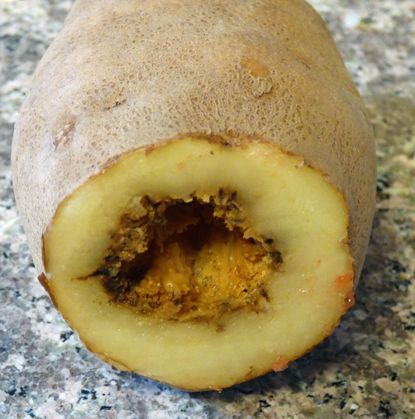Potato Hollow Heart: What To Do For Hollow Heart Disease In Potatoes


Growing potatoes is fraught with mystery and surprises, especially for the beginning gardener. Even when your potato crop comes out of the ground looking perfect, the tubers can have internal defects that make them appear to be diseased. Hollow heart in potatoes is a common problem caused by alternating periods of slow and fast growth. Read on to learn more about hollow heart disease in potatoes.
Hollow Heart Potato Disease
Although many people refer to hollow heart as a disease of potato, there is no infectious agent involved; this problem is purely environmental. You probably won't be able to tell the potatoes with hollow heart apart from the perfect potatoes until you cut into them, but, at that point, it will be obvious. Hollow heart in potatoes manifests as an irregularly-shaped crater in the potato's heart -- this empty area may have a brown discoloration, but that isn't always the case. When environmental conditions fluctuate rapidly during potato tuber development, hollow heart is a risk. Stressors like inconsistent watering, large fertilizer applications, or highly variable soil temperatures increase the likelihood that hollow heart will develop. It's believed that rapid recovery from stress during tuber initiation or bulking rips the heart out of the potato tuber, causing the crater inside to form.
Potato Hollow Heart Prevention
Depending on your local conditions, hollow heart can be difficult to prevent, but following a consistent watering schedule, applying a deep layer of mulch to your plants, and dividing fertilizer into several small applications can help protect your potatoes. Stress is the number one cause of potato hollow heart, so make sure that your potatoes are getting everything they need from the get-go. Planting potatoes too early may play a part in hollow heart. If hollow heart plagues your garden, waiting until the soil has reached 60 F. (16 C.) may help prevent sudden growth. A layer of black plastic can be used to warm the soil artificially if your growing season is short and potatoes must go out early. Also, planting larger seed pieces that haven't been significantly aged seems to be protective against hollow heart due to an increased number of stems per seed piece.
Gardening tips, videos, info and more delivered right to your inbox!
Sign up for the Gardening Know How newsletter today and receive a free download of our DIY eBook "Bring Your Garden Indoors: 13 DIY Projects For Fall And Winter".

Kristi Waterworth was a regular contributor to Gardening Know How for many years, answering countless queries on plant pests and diseases.
-
 Gifts For Bird Lovers, Birders and Birdies To Attract More Feathered Friends To Your Yard!
Gifts For Bird Lovers, Birders and Birdies To Attract More Feathered Friends To Your Yard!If you’re looking to bring more birdies to your garden, these gifts for bird lovers should definitely be on your wish list. Grab some avian attractions to get your gardens all aflutter
By Janey Goulding
-
 Elegant Exotics: 8 Beautiful Amaryllis Varieties That Will Brighten Any Holiday Display
Elegant Exotics: 8 Beautiful Amaryllis Varieties That Will Brighten Any Holiday DisplayWhether red, pink, white or variegated, the right amaryllis varieties can enhance any living space, especially during the holidays. We round up eight of the most exquisite
By Bonnie L. Grant